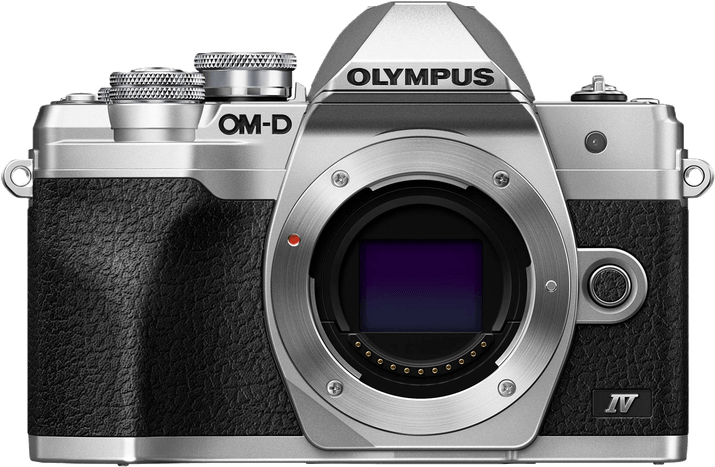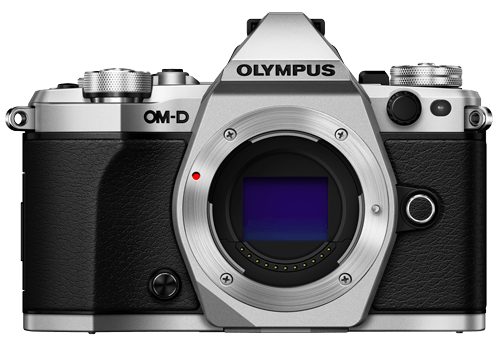Olympus OM-D E-M10 Mark IV vs OM-D E-M5 Mark II Comparison
Olympus OM-D E-M10 Mark IV

Olympus OM-D E-M5 Mark II

The Olympus OM-D E-M10 Mark IV outperforms the Olympus OM-D E-M5 Mark II with a score of 63/100 compared to 59/100. Both cameras are mirrorless and share similar dimensions, with the E-M10 Mark IV measuring 122 x 84 x 49mm and the E-M5 Mark II at 124 x 85 x 45mm.
The E-M10 Mark IV has the advantage of being lighter, weighing 383g (0.84lbs) as opposed to the E-M5 Mark II’s 469g (1.03lbs). Additionally, the E-M10 Mark IV is more recent, released in 2020, and has a lower launch price of $699 compared to the E-M5 Mark II’s $1100 in 2015.
Despite its lower score, the E-M5 Mark II still offers a compact design with a slightly smaller depth. However, considering the E-M10 Mark IV’s higher score, lighter weight, and more affordable price, it emerges as the superior choice between the two.
Olympus OM-D E-M10 Mark IV vs OM-D E-M5 Mark II Overview and Optics
The Olympus OM-D E-M10 Mark IV wins the optics comparison with a score of 63/100, while the Olympus OM-D E-M5 Mark II scores 58/100. Both cameras share several specifications, such as the CMOS sensor type, Micro Four Thirds sensor size, Micro 4/3 lens mount, and image stabilization. Additionally, both cameras have a DXOMARK score of 73 for their sensors.
The E-M10 Mark IV has advantages in megapixels and shooting speed. With 20 megapixels, it captures more detail than the E-M5 Mark II, which has 16.1 megapixels. This difference allows for better image quality and larger prints. The E-M10 Mark IV also has a faster shooting speed of 15 frames per second compared to the E-M5 Mark II, which shoots at 10 frames per second. This increased speed is beneficial for capturing fast-moving subjects and action shots.
The E-M5 Mark II, despite its lower score, has a more advanced processor, the TruePic VII, compared to the E-M10 Mark IV’s TruePic VIII. This results in better color reproduction and noise reduction. However, the difference in the processor does not significantly impact the overall image quality.
In conclusion, the Olympus OM-D E-M10 Mark IV outperforms the E-M5 Mark II in terms of optics, primarily due to its higher megapixel count and faster shooting speed. The E-M5 Mark II’s advantage in processor technology is not enough to compensate for its lower megapixel count and slower shooting speed. Therefore, the E-M10 Mark IV is the better choice for those seeking superior optics performance.
Olympus OM-D E-M10 Mark IV vs OM-D E-M5 Mark II Video Performance
The Olympus OM-D E-M10 Mark IV outperforms the Olympus OM-D E-M5 Mark II in video capabilities with a video score of 83/100 compared to 70/100. Both cameras share some common features, such as a maximum video frame rate of 60fps and built-in time-lapse functionality.
The E-M10 Mark IV surpasses the E-M5 Mark II in terms of video resolution and dimensions. It offers 4K video resolution (3840 x 2160) which is significantly higher than the E-M5 Mark II’s Full HD resolution (1920 x 1080). This difference in resolution enables the E-M10 Mark IV to produce sharper and more detailed videos, making it the superior choice for videographers.
While the E-M5 Mark II’s video capabilities are not as advanced as the E-M10 Mark IV’s, it still provides a respectable Full HD resolution and shares the same maximum video frame rate of 60fps. This means that both cameras can capture smooth and fluid motion in their videos, even though the E-M5 Mark II’s resolution is lower.
To conclude, the Olympus OM-D E-M10 Mark IV is the winner in terms of video capabilities due to its higher video score and superior 4K resolution. The E-M5 Mark II, while not as proficient in video quality, still offers a solid Full HD resolution and shares the same 60fps maximum video frame rate. Therefore, those who prioritize video quality should opt for the E-M10 Mark IV, while the E-M5 Mark II remains a decent option for those who do not require 4K resolution.
Olympus OM-D E-M10 Mark IV vs OM-D E-M5 Mark II Features and Benefits
The Olympus OM-D E-M10 Mark IV wins the comparison with a feature score of 70/100, a 13-point difference from the Olympus OM-D E-M5 Mark II, which scores 57/100. Both cameras have common specifications, including a 3-inch screen, touchscreen capabilities, flip screen, GPS absence, and WIFI connectivity. However, the E-M10 Mark IV outperforms the E-M5 Mark II in certain areas.
The E-M10 Mark IV has a higher screen resolution of 1,040,000 dots compared to the E-M5 Mark II’s 1,037,000 dots. Moreover, the E-M10 Mark IV has Bluetooth connectivity, while the E-M5 Mark II lacks this feature. These advantages make the E-M10 Mark IV a more attractive option for photographers who prioritize screen quality and wireless connectivity.
On the other hand, the E-M5 Mark II has its own merits. Although the E-M5 Mark II has a lower feature score, it still offers a quality touchscreen experience with its 3-inch flip screen and WIFI connectivity. The absence of Bluetooth may not be a dealbreaker for some users who primarily rely on WIFI for transferring files and remote control.
To conclude, the Olympus OM-D E-M10 Mark IV proves to be a better choice due to its higher feature score, superior screen resolution, and the added benefit of Bluetooth connectivity. While the E-M5 Mark II may not be the winner, it still provides adequate features for photographers who can compromise on Bluetooth and a slightly lower screen resolution.
Olympus OM-D E-M10 Mark IV vs OM-D E-M5 Mark II Storage and Battery
The Olympus OM-D E-M10 Mark IV outperforms the OM-D E-M5 Mark II in storage and battery with a score of 35/100 compared to 21/100. Both cameras share similarities, including one memory card slot and compatibility with SD, SDHC, and SDXC memory cards. However, the E-M10 Mark IV has the advantage of UHS-II compatibility.
The E-M10 Mark IV also offers better battery life with 360 shots, using the BLS-50 battery type, and features USB charging. In contrast, the E-M5 Mark II has a slightly lower battery life of 310 shots and uses the BLN-1 battery type, without USB charging capabilities.
Despite the lower score, the E-M5 Mark II still provides adequate battery life and storage options for most photography needs. However, the E-M10 Mark IV’s superior battery life, UHS-II compatibility, and USB charging make it a more convenient choice for extended use and faster data transfer.
Olympus OM-D E-M10 Mark IV vs OM-D E-M5 Mark II – Our Verdict
Are you still undecided about which camera is right for you? Have a look at these popular comparisons that feature the Olympus OM-D E-M10 Mark IV or the Olympus OM-D E-M5 Mark II:

